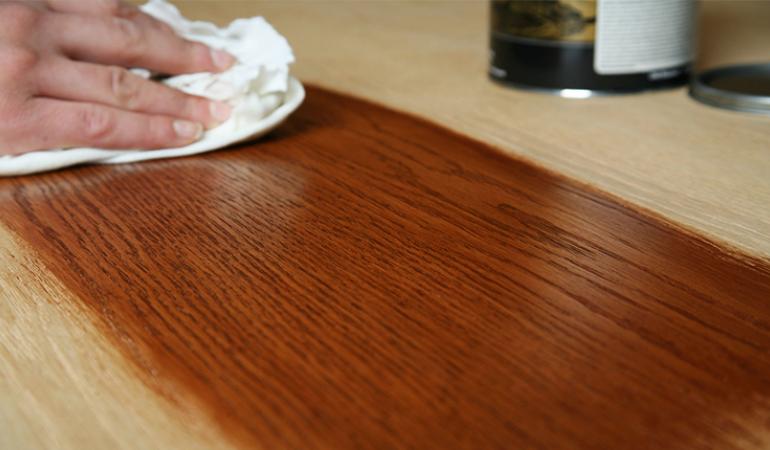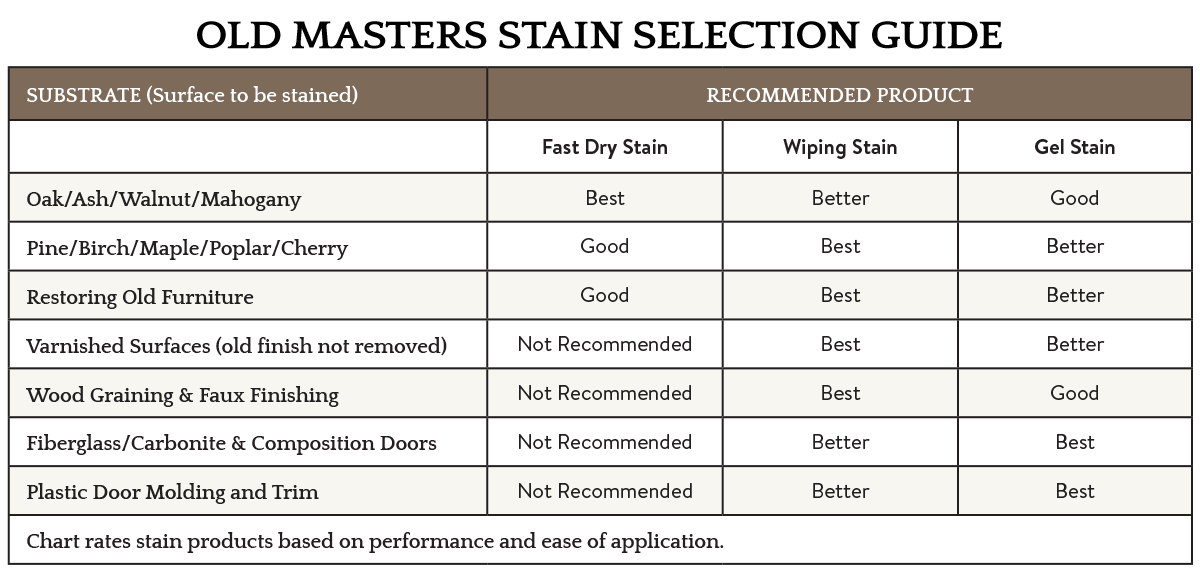Suggested Supplies
Stain
Scrap test piece
Stir stick
Drop cloth
Lint-free cloth
Bristle brush, synthetic brush, foam brush applicator, cheesecloth, or rags
Mineral spirits or paint thinner
Rubber gloves
Old Masters uses only the finest ingredients to create the highest quality stains available today. Old Masters stains can be used to:
- Add rich color and depth to a variety of surfaces
- Change existing colors on previously finished surfaces
- Match color tone on different kinds of woods and non-porous surfaces, such as fiberglass.
Each Old Masters stain is uniquely formulated to fulfill different functions. Read the following descriptions to help you choose the right stain for your project.
Fast Dry Stain offers speed, versatility, and unrivaled performance by combining rapid dry time and easy application with the intensity and color control typical of a wiping stain. Fast Dry Stain is recommended for use on interior wood surfaces or surfaces on which the previous finish has been removed. This stain is preferred for hardwoods, such as oak, ash, walnut, and mahogany.
Wiping Stain can be used on a variety of surfaces, including unfinished wood, previously finished surfaces, fiberglass, metal, and composition surfaces. It is especially recommended for woods such as pine, birch, maple, poplar, and cherry.
Gel Stain is specifically formulated for use on nonporous surfaces, such as fiberglass, metal, and composition surfaces, and is also suitable for wood applications. It is especially recommended for woods such as pine, birch, maple, poplar, and cherry. Gel Stain is excellent for vertical surfaces.
Water-Based Wood Stain is recommended for use on bare, interior wood surfaces or surfaces from which the previous finish has been removed. This stain is fast drying and cleans easily with soap and water.
Use the following steps for general stain application on properly prepared wood surfaces.
- Test your stain on a hidden section of the project or on a scrap piece of a similar wood to verify the desired color.
- Ensure the surface is clean, dry, and free from dirt, wax, grease, glue, and other contaminants or penetration and adhesion will be affected.
- Apply the stain by brush, foam brush applicator, cloth, or lambswool stain applicator. Stain can also be applied by spraying. Apply a smooth, even coat.
- Allow the stain to set for approximately 5 to 15 minutes. The longer you let the stain set, the deeper and richer the color will be. Note: humidity and temperature are key factors in the setting and drying of stain, be sure to read the back of the label for detailed information.
- While the stain is still wet, wipe off the excess with a clean cloth. Take care not to remove too much from corners and edges. Wipe across or against the grain first to work the stain into the wood pores. The final wipe should always be with the grain.
- For a deeper color, apply another coat of stain after the first coat has thoroughly dried, approximately 6-12 hours. Follow steps 3 through 5.
- Once satisfied with the color, allow the stain to dry. Drying may take 6-12 hours. Ensure stain is thoroughly dry before applying a clear finish; overnight drying is strongly recommended.
Stripping the finish is not always necessary to change the color of your woodworking projects. Start by thoroughly cleaning your project. Sand it lightly with a fine grit sandpaper and then remove the dust with a tack cloth. Using Old Masters Wiping Stain or Gel Stain, apply a thin coat to start and feather it with a dry, soft- tipped bristle brush. Recoat your project with 2 to 3 coats of an Old Masters clear finish to protect the new, rich color.
For closed-grain hardwoods, we recommend using Old Masters Wiping Stain, but instead of wiping off the excess stain as normally done, try brushing out the excess stain. This will give you a more uniform appearance and color intensity.
Old Masters Gel Stain is specifically designed to adhere to fiberglass doors and plastic trim. Apply it directly to the fiberglass surface. Wiping Stain also works well on these projects, especially as a second coat or intermixed with Gel Stain. For complete instructions on how to stain fiberglass doors, refer to our Fiberglass Doors Staining Guide.
Old Masters offers a wide variety of products and tools used to create unique faux finishes. This section offers a brief overview of these techniques and various products and tools needed to complete each faux finish.
Wood Graining
Old Masters offers a complete wood graining system. Create beautiful and unique wood grained finishes on steel doors and other smooth surfaces using Old Masters Wiping or Gel Stain, a base color of your choice, and a Wood Graining Tool. Detailed instructions on wood graining can be found on our website and are also included with our wood graining tool.
Antiquing
Antiquing is a common technique used to give painted or stained woodwork an aged look. We suggest accomplishing the antiqued look by using Old Masters Wiping Stain over top of your chosen paint color. After applying a coat of Wiping Stain, wipe the center of the work area clean and build stain gradually to the edges. No abrupt changes from light to dark areas should remain to complete the motif.
Marbling
Marbling is a common faux finish used in painting, but it can also create a very interesting effect with wood stains on wood surfaces. Start by applying a coat of Old Masters Wiping Stain in a color of your choosing to any painted or stained surface. Create the look of marble by crumpling a dry, clean plastic bag. Next, open the bag and lay it on top of the wet stain, pressing the wrinkles into the stain. Create much more intense variations by using other objects such as sponges, rags, or carpet in combination with two or more stain colors.
Distressing
Distressing may seem similar to antiquing, but antiquing makes a piece look old, whereas distressing makes a piece look worn. Creating a distressed look can be accomplished by applying burn marks, nail heads, intentional dents or scratches, and other similar attempts at marring the surface. Applying a stain before this distressing will allow the original wood to show through the stain; applying the stain after the distressing will pool in the imperfections and create dark blemishes. Wiping Stain or Gel Stain is a great option for enhancing the marred surface of your project. Add a splatter effect by dipping an old toothbrush in Wiping Stain and flinging it onto the project.
Wood Graining Tool
Our Wood Graining Tool offers the quickest and easiest method of creating a natural wooden appearance on any smooth surface such as steel doors and other smooth surfaces. No special skills are required. Multiple woodgrain patterns can be produced with this tool.
Tinting Glaze
Old Masters Tinting Glaze is a tintable glaze or base for use in creating antique, graining, or faux finishes. It can be tinted with any universal colorants or oil-based paint to provide a wide choice of decorating effects when applied over satin or eggshell enameled surfaces, including furniture, trim, or walls. As a wood stain, Tinting Glaze can be tinted with universal colorants or intermixed with solvent-based stains to create custom colors.









